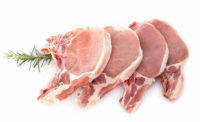STATE OF THE INDUSTRY: PORK
State of the Industry: The next generation of pork consumers
Pork industry must embrace opportunities to connect with younger demographics.

In this summer’s Olympic Games in Paris, 385 bronze medals were awarded to competitors from more than 200 countries. In a premiere global sporting event that occurs once every four years, third place is something that most athletes only dream of but very few achieve. For the National Pork Board (NPB) and the 60,000 pig farmers it represents, third place seems like second best.
Domestic pork consumption during the past few decades has been stagnant. Ignoring the boon that the COVID-19 pandemic was for the retail meat case and pork in particular, the long-term trend has remained flat to declining on a pounds-per-person-per-year basis.
“We’ve been stuck at the plateau at about 50 pounds per person per year for the last several decades,” said Patrick Fleming, NPB’s vice president of demand development. “While we didn’t necessarily lose ground, we’re losing our key customers, and we’ve got to start making the case for pork with younger generations.”
Fleming noted that it’s a pivotal moment for the pork industry, which has consistently remained behind beef and chicken consumption in the U.S.
“Baby Boomers have a high affinity for pork, but they’re aging out,” he adds. “Unfortunately, the younger generations – Millennials and Generation Z especially – don’t have the same perceptions and love for pork as their parents and grandparents.”
To move the consumption needle in a positive direction, NPB is working to help the industry understand the importance of making pork more relevant and relatable to younger Americans, encouraging them to eat more pork more often.
Grounding the pork supply chain in this reality is imperative, but not without its challenges. While previous generations could be reached en masse through television, radio and print media, today’s digital world has made a “one-size-fits-all” approach to connecting and remaining relevant and relatable to consumers difficult.
NPB’s Consumer Connect is the first step in building pork relevance among younger consumers. The work is backed by extensive and sophisticated market research funded by Pork Checkoff dollars that includes food supply chain sales, purchase patterns, retail, and meat case behavior, as well as a greater understanding of the motivations, drivers, and attitudes about pork and food in general.
NPB worked with a company specializing in consumer market segmentation, data providers, and market research consultants to identify and categorize seven distinct consumer segments. The segments were identified by conducting:
- An online anthropology that analyzed 20 million social media posts from approximately
5 million accounts - An online quantitative survey of more than 7,500 consumers
- A five-day online qualitative community analysis of 60 consumers
- 28 in-depth one-on-one discussions with consumers
Additionally, the segmentation typing tool is tied into Numerator data, which tracks the shopping and purchasing habits, media preferences, and psychographics of shoppers in the U.S.
The end result? More than 50,000 households (which were then projected up to 150,000 shoppers) were classified into specific segments that allow the Pork Board to monitor and measure pork performance and key metrics by region, retailer, and across the U.S. This also enables the Pork Board to better understand consumer habits as they move to food service channels.
According to Kiersten Hafer, NPB’s vice president of data and insights, Consumer Connect significantly differentiates from segmentation work done by commodity marketing groups.
“Most segmentation strategies stop at identifying consumer groups,” she explained. “Our work identifies the people in each segment, but we also know how to find them and talk to them about the things they care about. We have tied each segment to specific growth strategies. We have segments we need to protect, but we’ve also identified segments where pork has growth opportunities – both in the short term and long term.”
By going beyond the “who” and into the “how and why,” Consumer Connect allows brands to take the data and move more quickly into informed activation strategies.
“The value to the pork supply chain can’t be overstated,” Hafer noted. “These insights allow the industry to focus on our most important consumers and help craft better-informed strategies that create actionable consumer pull-through strategies that packers, retailers, and food service partners can fund confidently.
To date, NPB’s market growth team has held more than 50 meetings with C-suite-level individuals of supply chain partners of every type and size to showcase the Consumer Connect playbook. The strategies outlined in the playbook identify how supply chain stakeholders can implement this research into their own branding and marketing.
“Helping decision-makers understand where and how to impact their brands and businesses was at the core of the work, and why we invested so heavily,” Hafer said. “This work has brought key investments, initiatives, and progress in areas like sustainability, nutrition, and demand together in a way that hasn’t been possible before now.”
Hafer points to several examples of how supply chain partners have used the insights, including:
- As a basis for brand and innovation research for brand development.
- Implementing the consumer-typing tool for their own research and/or coding it into their own custom segmentation.
- Positioning and selling branded products with segments as their priority targets.
- Tiering brands and messaging
- Reviewing current branded offerings, product innovation, and products in the pipeline through the lens of consumer needs and wants.
- Evolving trade promotion plans and evaluating the brands, products, and merchandising materials used throughout the shopper journey.
- Ideating menus and new limited-time offers featuring fresh pork as an ingredient.
- Tracking issues and understanding which segments need to be prioritized based on topics that could pose a risk to their confidence in pork.
“This is the best time in the past 40 years to reposition pork for the long term,” Fleming said. “We have generations that don’t have the affinity for pork like Boomers did. While that could be interpreted as a threat to our future success, we have a blank slate to engage younger Americans around what matters to them, build a brand they love, and share the flavors and versatility that are unique to pork.”
Looking for a reprint of this article?
From high-res PDFs to custom plaques, order your copy today!





